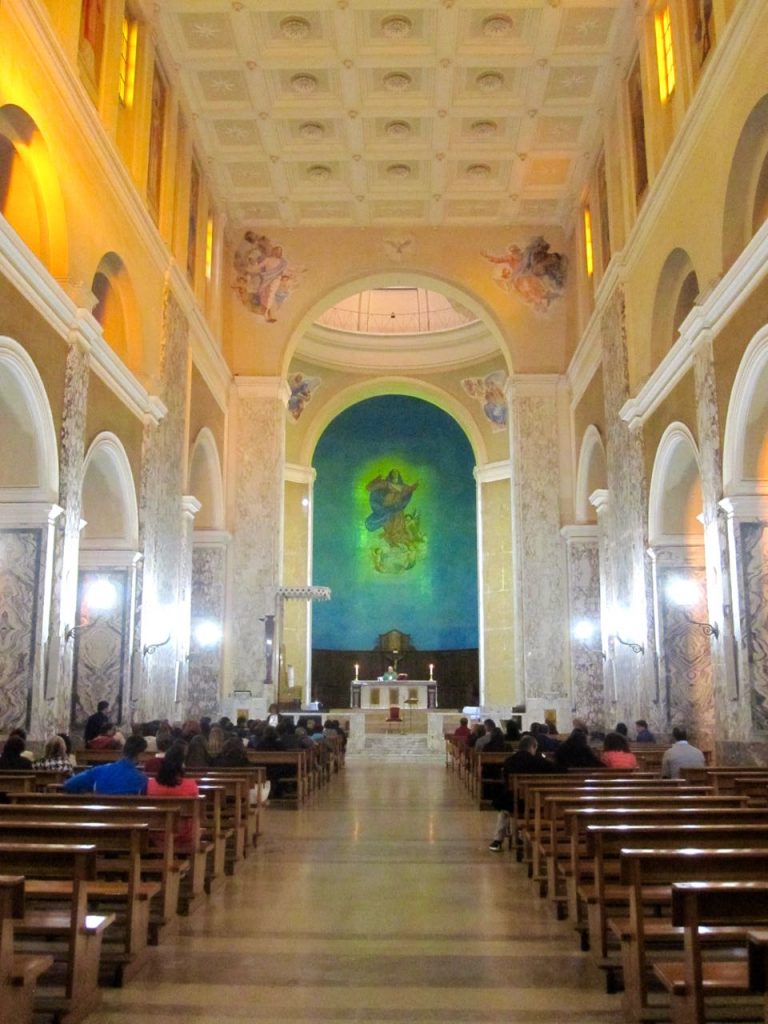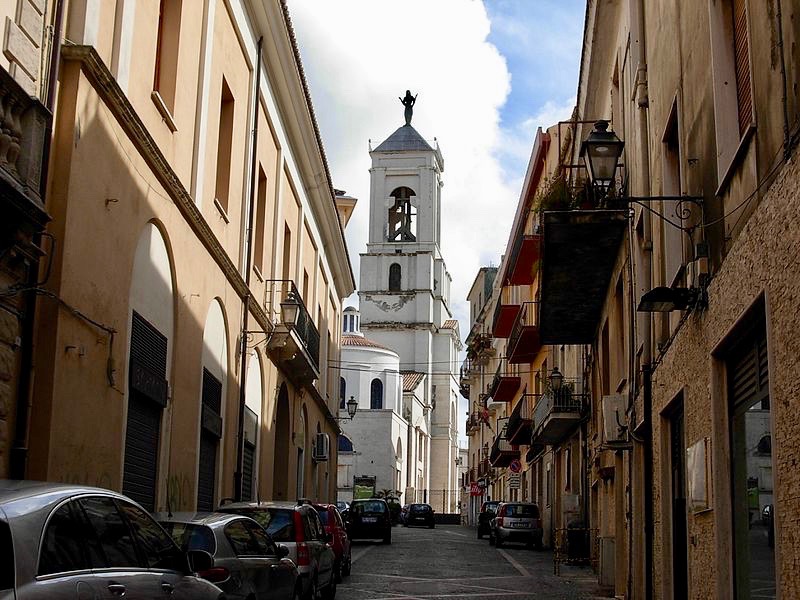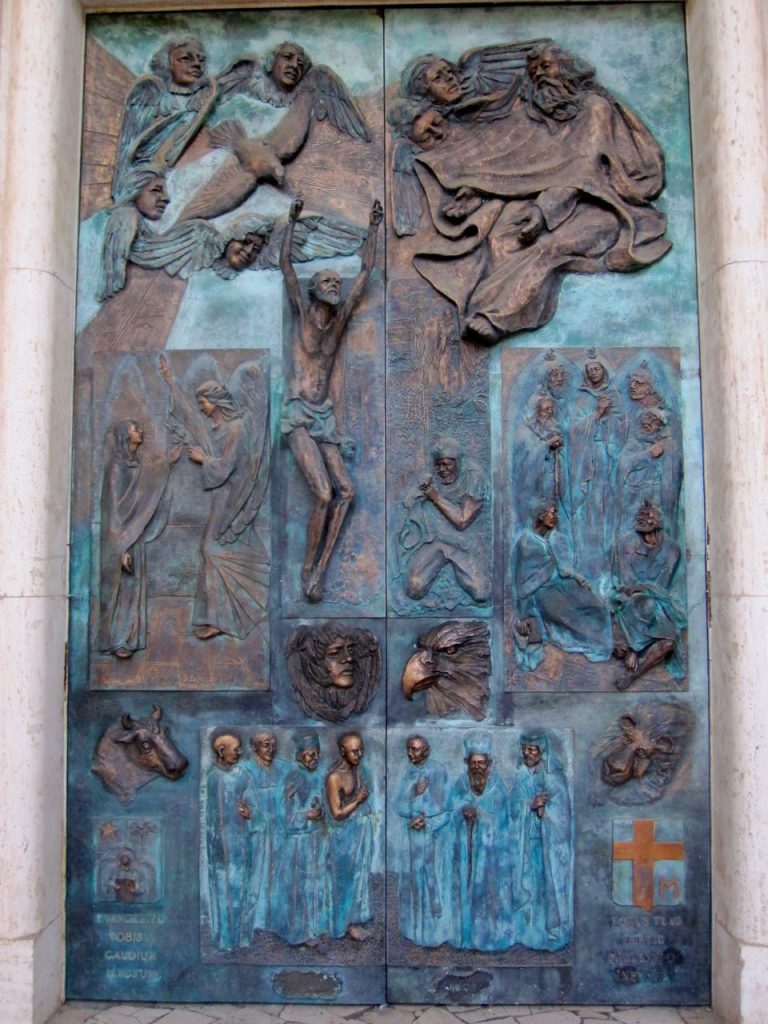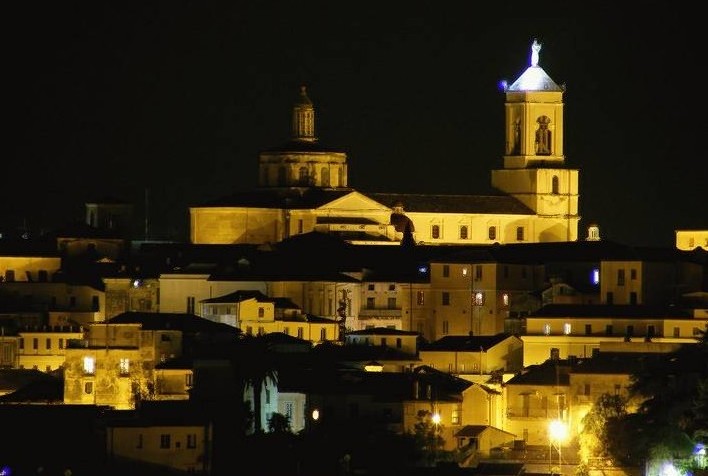Every town has its legends, some from recent history and others reach back several historical periods to a time when the stories were passed down verbally. These accounts become part of the collective history of a place, a narrative that today’s generation often seeks to record and archive for the future. The story of the wooden ecclesiastics of the Catanzaro cathedral embodies a timeless furbizia or shrewdness.
Considering Italy’s convoluted bureaucracy and cumbersome legal system, the desire and/or necessity to circumvent the establishment isn’t new. It makes one wonder, which came first – the complicated modus operandi or the cleverness to maneuver within or around them.

View of the Old Town of Catanzaro (photo courtesy of AQUILAGIALLOROSSA, Wikimedia)
Once upon a time in Catanzaro, the religious community found itself in a predicament. Sovereign donations were allocated in proportion to the institution’s importance and the number of its members. Just before the royal inspection that would determine the amount of money allotted to the cathedral’s charterhouse, an unprecedented number of their canons died. Without time to elect substitutes, the community faced a drastic reduction in funding.
What does any good Italian do, religious or not, when confronted with such a quandary? He falls back on furbizia. The bishop and dean put their heads together and in a flash of brilliance came up with the idea of substituting wooden mannequins for the deceased members of their group. Who would notice? They were all old anyway, sitting hunched over in their chairs, half dozing or completely asleep.
A craftsman was hired; the dummies were intricately carved and meticulously dressed in traditional cassocks and vestments; and the ersatz canons were positioned in the choir stalls of the Catanzaro cathedral. The sly ecclesiastics were confident in pulling off the disguise, as the inspectors wouldn’t ever have suspected such a deception and would have simply given the canons a quick count not to interrupt the solemn Mass.
The bishop and dean weren’t without scruples. However, to assuage any possible pangs of conscience, they reasoned that if they were committing fraud, it was all done for a good cause. It could be considered an act of faith.
The strategy went off smoothly, exactly as planned. The inspectors glanced over at the charter house assembly and authorized a proportionate funding for the Catanzaro cathedral. The deception was so easy that the perpetrators couldn’t resist another episode of furbizia. The ploy was repeated in the following years until a rumor of the subterfuge reached the ears of royal officials.

Catanzaro Cathedral – “Cattedrale metropolitana di Santa Maria Assunta”
Not wanting to admit that they had been hoodwinked, the functionaries let bygones be bygones. From that time forward, however, the official counting of the canons was more than a quick visual summary. The royal functionaries did a physical check, as well, to make sure that the stalls were filled with clergymen of real flesh and blood.
The story survives today in the form of an expression in the local dialect, the catanzarese language: “Finì ‘u tempu de’ canonici’ e lignu.” The time of the wooden ecclesiastics is over. In other words, once someone’s eyes have been opened, he will no longer be prone to being coaxed out of performing his duties.

Via Duomo with the cathedral’s bell tower (photo courtesy of Salvatore Migliari, Wikimedia)
The story of Wooden Ecclesiastics in the Catanzaro Cathedral is adapted from Giulio Palange’s Guida alla Calabria Misteriosa (Rubbettino, 2010)
About the Catanzaro Cathedral: Originally built in 1121, the Catanzaro Cathedral saw numerous modifications over the years and suffered many natural and human catastrophes, most notably earthquakes, such as that of 1638, and the Allied bombing of the Second World War. The city of Catanzaro was bombed on August 1943 by Anglo-American forces, causing the loss of 132 lives in addition to the irreparable damage to the cathedral.

A pair of contemporary bronze doors at a side entrance to the Catanzaro Cathedral
Stroll through a beautiful park in my blogpost Contemporary Art in the Catanzaro Park of Biodiversity or read about a religious festival in my post The Festival of the Madonna in Reggio Calabria.
 For an in-depth look at the beautiful land in the toe of the boot, check out Calabria: The Other Italy, my non-fiction book about daily life, history, culture, art, food and society in this fascinating southern Italian region. It’s available in paperback and e-book versions.
For an in-depth look at the beautiful land in the toe of the boot, check out Calabria: The Other Italy, my non-fiction book about daily life, history, culture, art, food and society in this fascinating southern Italian region. It’s available in paperback and e-book versions.
“Like” Calabria: The Other Italy’s Facebook page and follow me on Karen’s Instagram and Karen’s Twitter for more beautiful pictures and information.
Sign up below to receive the next blog post directly to your email for free.

Comments 12
What a great story! Do any of the wooden mannequins still exist?
Author
I haven’t heard if any of the mannequins still exist, but I doubt it. Glad you enjoyed the tale.
Wow, that’s real ingenuity! Maybe I could make a wooden dummy of myself playing in the orchestra & hope that nobody would notice I wasn’t there 😉
Author
Ha, ha, good one! Definitely worth a try for pit services.
Love your posts! About when did this occur? For some reason I imagine it taking place in the 18th or 19th centuries–corrupt & lazy Kingdom of Naples officials? But hard to see why dressing up an assortment of peasants wouldn’t have worked better!
Author
Thanks. The story I read didn’t give a period. I imagined a bit further back in time but perhaps I was influenced by my mental vision of old, elaborately carved wooden choir stalls. But you’re right about the peasants, it never crossed my mind!
Now, that’s Italian! Loved the story!
Author
Davvero, grazie!
Reading your story I was thinking how elaborate the deception was! I wonder how much they paid the poor wood worker who had to carve all those life-sized ecclesiastics?
Author
Now that’s a good question. I doubt he saw any appreciable percentage of the take.
My paternal grandparents came from this area of Calabria. They immigrated to America at the turn of the 20th century as children. I have a copy of your book. And, a second cousin own a hotel on the mountain side in Calabria.
Author
So much history and surely so many stories passed down. I hope you enjoy the experiences and history I share in my book and blog, and also that you’ve had or you will have the opportunity to visit the area and meet your cousins.